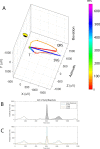Electrocardiogram machine learning for detection of cardiovascular disease in African Americans: the Jackson Heart Study
- PMID: 34048510
- PMCID: PMC8139412
- DOI: 10.1093/ehjdh/ztab003
Electrocardiogram machine learning for detection of cardiovascular disease in African Americans: the Jackson Heart Study
Erratum in
-
Erratum.Eur Heart J Digit Health. 2021 Nov 21;3(1):115-116. doi: 10.1093/ehjdh/ztab098. eCollection 2022 Mar. Eur Heart J Digit Health. 2021. PMID: 36713986 Free PMC article.
Abstract
Aims: Almost half of African American (AA) men and women have cardiovascular disease (CVD). Detection of prevalent CVD in community settings would facilitate secondary prevention of CVD. We sought to develop a tool for automated CVD detection.
Methods and results: Participants from the Jackson Heart Study (JHS) with analysable electrocardiograms (ECGs) (n=3679; age, 6212 years; 36% men) were included. Vectorcardiographic (VCG) metrics QRS, T, and spatial ventricular gradient vectors magnitude and direction, and traditional ECG metrics were measured on 12-lead ECG. Random forests, convolutional neural network (CNN), lasso, adaptive lasso, plugin lasso, elastic net, ridge, and logistic regression models were developed in 80% and validated in 20% samples. We compared models with demographic, clinical, and VCG input (43 predictors) and those after the addition of ECG metrics (695 predictors). Prevalent CVD was diagnosed in 411 out of 3679 participants (11.2%). Machine learning models detected CVD with the area under the receiver operator curve (ROC AUC) 0.690.74. There was no difference in CVD detection accuracy between models with VCG and VCG + ECG input. Models with VCG input were better calibrated than models with ECG input. Plugin-based lasso model consisting of only two predictors (age and peak QRS-T angle) detected CVD with AUC 0.687 [95% confidence interval (CI) 0.6250.749], which was similar (P=0.394) to the CNN (0.660; 95% CI 0.5970.722) and better (P<0.0001) than random forests (0.512; 95% CI 0.4930.530).
Conclusions: Simple model (age and QRS-T angle) can be used for prevalent CVD detection in limited-resources community settings, which opens an avenue for secondary prevention of CVD in underserved communities.
Keywords: Cardiovascular disease; ECG; Machine learning; QRS-T angle.
The Author(s) 2021. Published by Oxford University Press on behalf of the European Society of Cardiology.
Figures






Comment in
-
The role of machine learning in the early detection of cardiovascular disease in a community setting.Eur Heart J Digit Health. 2021 Feb 5;2(1):135-136. doi: 10.1093/ehjdh/ztab015. eCollection 2021 Mar. Eur Heart J Digit Health. 2021. PMID: 36711178 Free PMC article. No abstract available.
Similar articles
-
Reliable Detection of Myocardial Ischemia Using Machine Learning Based on Temporal-Spatial Characteristics of Electrocardiogram and Vectorcardiogram.Front Physiol. 2022 May 30;13:854191. doi: 10.3389/fphys.2022.854191. eCollection 2022. Front Physiol. 2022. PMID: 35707012 Free PMC article.
-
Sex differences in vectorcardiogram of African-Americans with and without cardiovascular disease: a cross-sectional study in the Jackson Heart Study cohort.BMJ Open. 2021 Jan 31;11(1):e042899. doi: 10.1136/bmjopen-2020-042899. BMJ Open. 2021. PMID: 33518522 Free PMC article.
-
Influence of the vectorcardiogram synthesis matrix on the power of the electrocardiogram-derived spatial QRS-T angle to predict arrhythmias in patients with ischemic heart disease and systolic left ventricular dysfunction.J Electrocardiol. 2011 Jul-Aug;44(4):410-5. doi: 10.1016/j.jelectrocard.2011.04.007. J Electrocardiol. 2011. PMID: 21704219
-
The Role of Machine Learning in the Detection of Cardiac Fibrosis in Electrocardiograms: Scoping Review.JMIR Cardio. 2024 Dec 30;8:e60697. doi: 10.2196/60697. JMIR Cardio. 2024. PMID: 39753213 Free PMC article.
-
Screening for Cardiovascular Disease Risk With Electrocardiography: An Evidence Review for the U.S. Preventive Services Task Force [Internet].Rockville (MD): Agency for Healthcare Research and Quality (US); 2018 Jun. Report No.: 17-05235-EF-1. Rockville (MD): Agency for Healthcare Research and Quality (US); 2018 Jun. Report No.: 17-05235-EF-1. PMID: 30212062 Free Books & Documents. Review.
Cited by
-
Limited Relationship Between Echocardiographic Measures and Electrocardiographic Markers of Left Ventricular Size in Healthy Children.Pediatr Cardiol. 2024 Jun;45(5):1055-1063. doi: 10.1007/s00246-024-03448-2. Epub 2024 Mar 23. Pediatr Cardiol. 2024. PMID: 38520508
-
Unlocking the link: predicting cardiovascular disease risk with a focus on airflow obstruction using machine learning.BMC Med Inform Decis Mak. 2025 Feb 3;25(1):50. doi: 10.1186/s12911-025-02885-0. BMC Med Inform Decis Mak. 2025. PMID: 39901185 Free PMC article.
-
Reliable Detection of Myocardial Ischemia Using Machine Learning Based on Temporal-Spatial Characteristics of Electrocardiogram and Vectorcardiogram.Front Physiol. 2022 May 30;13:854191. doi: 10.3389/fphys.2022.854191. eCollection 2022. Front Physiol. 2022. PMID: 35707012 Free PMC article.
-
Latent profiles of global electrical heterogeneity: the Hispanic Community Health Study/Study of Latinos.Eur Heart J Digit Health. 2024 Jul 8;5(5):611-621. doi: 10.1093/ehjdh/ztae048. eCollection 2024 Sep. Eur Heart J Digit Health. 2024. PMID: 39318685 Free PMC article.
-
Digitizing ECG image: A new method and open-source software code.Comput Methods Programs Biomed. 2022 Jun;221:106890. doi: 10.1016/j.cmpb.2022.106890. Epub 2022 May 14. Comput Methods Programs Biomed. 2022. PMID: 35598436 Free PMC article.
References
-
- Virani SS, Alonso A, Benjamin EJ, Bittencourt MS, Callaway CW, Carson AP, Chamberlain AM, Chang AR, Cheng S, Delling FN, Djousse L, Elkind MSV, Ferguson JF, Fornage M, Khan SS, Kissela BM, Knutson KL, Kwan TW, Lackland DT, Lewis TT, Lichtman JH, Longenecker CT, Loop MS, Lutsey PL, Martin SS, Matsushita K, Moran AE, Mussolino ME, Perak AM, Rosamond WD, Roth GA, Sampson UKA, Satou GM, Schroeder EB, Shah SH, Shay CM, Spartano NL, Stokes A, Tirschwell DL, VanWagner LB, Tsao CW; American Heart Association Council on Epidemiology, Prevention Statistics Committee, Stroke Statistics Subcommittee. Heart Disease and Stroke Statistics-2020 update: a report from the American Heart Association. Circulation 2020;141:e139–e596. - PubMed
-
- Carnethon MR, Pu J, Howard G, Albert MA, Anderson CAM, Bertoni AG, Mujahid MS, Palaniappan L, Taylor HA Jr, Willis M, Yancy CW.. Cardiovascular health in African Americans: a scientific statement from the American Heart Association. Circulation 2017;136:e393–e423. - PubMed
Grants and funding
LinkOut - more resources
Full Text Sources
Other Literature Sources
